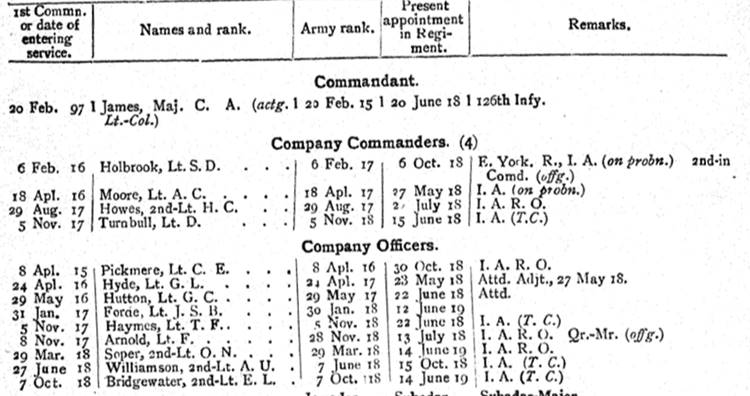This article is about the 2nd Battalion 153rd Punjabis and will help you to research both the Battalion and those soldiers who served with it during the First World War. I have also written guides to the 1st and 3rd Battalions:
The 2nd Battalion 153rd Punjabis
Lineage: Formed Sarafand, Palestine in May 1918 and disbanded on 15 June 1921.
Class Composition of Battalion in 1919: 1 1/2 Companies of Punjabi Muslims, 2 Company of Sikhs, 1/2 a Company of Hindustani Muslims.
The 2nd Battalion 153rd Punjabis was one of eighteen Indian infantry battalions raised in the field in 1918. These Battalions were created from drafts of other regiments to replace British battalions leaving the Middle East for France. This was in consequence of the German Spring Offensive which began in March 1918 and the large casualties sustained by the British Army. The 2nd Battalion 153rd Punjabis was formed at Sarafand, Palestine from:
- B Company 74th Punjabis (arrived last on 15 June 1918)
- D Company 91st Punjabis
- B Company 92nd Punjabis
- A Company 93rd Burma Infantry
Once formed, the Battalion served with the 159th Infantry Brigade, 53rd (Welsh) Division for the remainder of the Palestine Campaign. The 2nd Battalion 153rd Punjabis took part in the Battle of Megiddo in September 1918 and returned to India in 1919. Once back in India, the Battalion served in the Third Anglo-Afghan War as part of Baluchistan Force in 1919 and was disbanded on 15 June 1921.
Below is an extra from the July 1919 Indian Army List which records the British officers serving with the 2nd Battalion 153rd Punjabis. Indian Army Lists are a fantastic resource to use when researching both British and Indian officers and Indian regiments. They are crammed full of military jargon and I have written a guide to help you: Indian Army Abbreviations and Acronyms.
War Diaries of the 2nd Battalion 153rd Punjabis
There are two war diaries for the Battalion and they can only be viewed at the National Archives. I have transcribed some entries from the war diaries below.
- Date: 01 May 1918 – 31 January 1919
- 159th Infantry Brigade, 53rd (Welsh) Division, Egyptian Expeditionary Force
- Reference: WO 95/4630
- Notes: A good war diary which contains detailed entries concerning the formation of the 2nd Battalion 153rd Punjabis. The diary contains a very large number of appendices, mostly orders of various types.
- Date: 30 May – 31 August 1919
- Baluchistan Force
- Reference: WO 95/5395
- Notes: Very little happens while the 2nd Battalion 153rd Punjabis is serving with Baluchistan Force. There is a list of British officers accompanying 2nd Battalion 153rd Punjabis to Karachi on 19 July 1919.
Further Sources for the 2nd Battalion 153rd Punjabis
If you are researching either a British or Indian officer who served with the 2nd Battalion 153rd Punjabis, the Indian Army List can be consulted. Unfortunately, there was no regimental history published for the 153rd Punjabis nor are there any confidential reports.
Extracts from the War Diaries of the 2nd Battalion 153rd Punjabis
01 May 1918 – 31 January 1919, Egyptian Expeditionary Force, WO 95/4630
27 May 1918 – Sarafend – 19.30 hours – D Company 91st Punjabis having arrived at Sarafend at 18.00 hours on the 23 May 1918… was joined at 19.30 hours on the 27 May by B Company 92nd Punjabis… this forming the 2nd Battalion 153rd Infantry.
30 May – 31 August 1919, Baluchistan Force, WO 95/5395
19 July 1919 – 15.00 – Entrained Regiment (12 British Officers, 20 Indian Officers, 783 Indian Other Ranks, 42 Public Followers, 15 Private Followers) for Bombay en route for Quetta via Karachi.
27 July 1919 – Harnai – Mules and baggage party arrived less 1 baggage wagon containing all mobilization stores.
30 July 1919 – Harnai -Missing wagon discovered at Sibi.
06 August 1919 – 06.00 – Marched for Loralai (17 miles). Came on looted tonga and dead horse at Inzor Ghat. At mile 43 from Harnai 2 ambulance tongas, 1 dead driver and 4 bullocks all wounded. About 300 yards ahead 4 men were seen on the skyline. On being accosted they ran away. Our scouts gave chase and captured three of them. They were taken to Loralai and investigation proved them to have been implicated in the murder.
30 August 1919 – Marched to mile 93. Regiment rear guard. The strength on this day is 12 British Officers, 17 Indian Officers, 609 Indian Other Ranks. 2 Indian Officers and 74 Indian Other Ranks proceeded on war leave and 101 Indian other ranks in hospital. The causes of sickness and colitis and malaria and in addition to men admitted to hospital there are 2 Indian Officers and 100 Indian Other Ranks sick at Lakaband without means of evacuation.
22 September 1919 – Regiment less 2 Companies marched to Zarozai. Raid on 2 villages 12 miles distant was contemplated but not carried out owing to threatening weather.

